15 Cute Animals That Have Invaded An Island.
Hi Steemians! Today im gonna talked about 15 islands that have been overrun with this beautiful creatures. Enjoy! :)
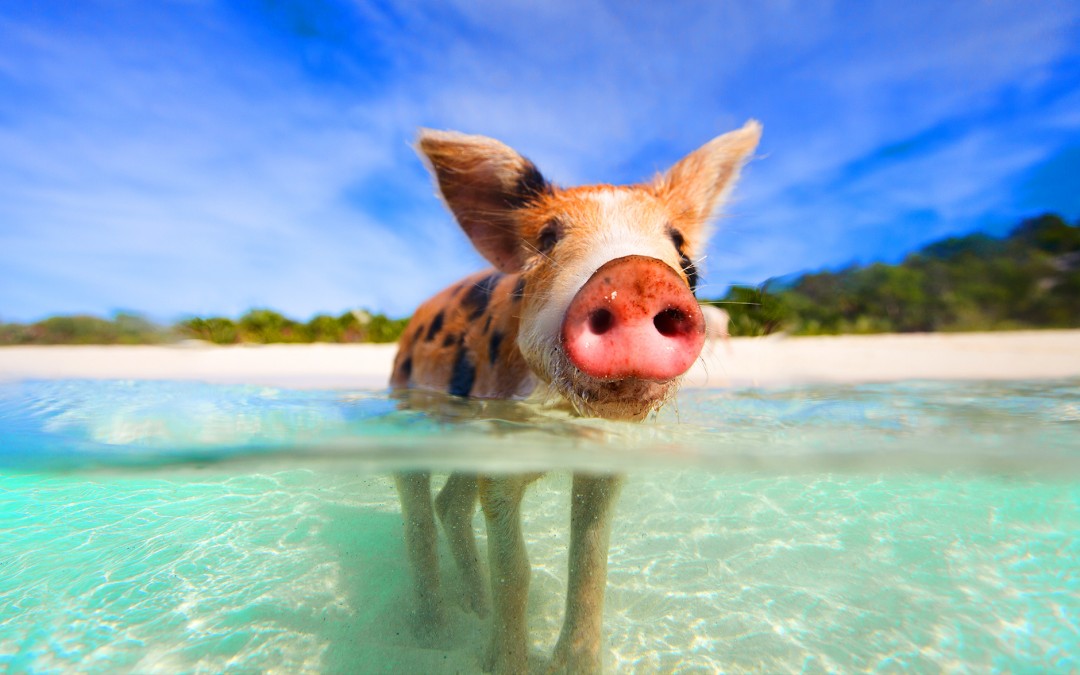
Source
Islands are prominent for a wide range of things. A few islands are well known tourist spots in view of their flawless shorelines, consummate surfing conditions, and excellent snorkeling reefs. Others are known for volcanoes, amazing climbing trails, or indigenous clans.
These 15 islands are astounding a direct result of their one of a kind creature population. Some of these animals draw sightseers from around the globe, some are secured from human contact, and some you may simply need to keep away from.
15 Island that have been invaded by cute animals.
_______________________________________________________________________________________________________
#1. Okunoshima,Japan-Rabbits
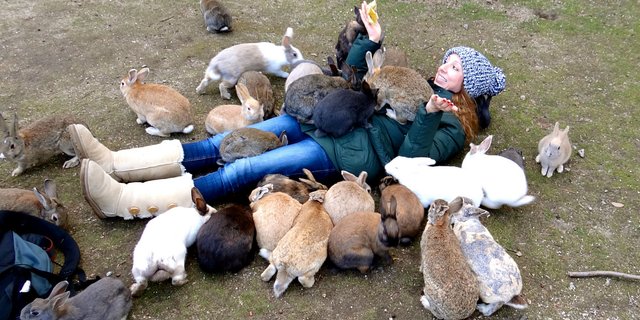
Source
Okunoshima is a little island found 3 kilometers (2 mi) off the shore of Japan. It is otherwise called Rabbit Island because of its vast population of benevolent non domesticated cushion balls. How rabbits were first acquainted with the island is faced off regarding. A few people say that the bunnies were deserted when Okunoshima was a mystery military site amid World War II. The minor island was expelled from all maps of Japan, and the area was utilized to deliver toxic gas that executed a huge number of individuals.
Rabbits were acquired to test the adequacy of the substance weapons. But numerous specialists can't help contradicting this hypothesis. They say that the test rabbits were totally wiped out and none had been left to go free on the island. A second hypothesis is that a school excursion to the island in 1971 may have deserted a couple of bunnies. With no regular predators on the island, the rabbit populace detonated to around 1,000 today.
Many appreciate going by the island to see the bunnies, yet tourism is having a negative effect. Individuals bolster the rabbits, which has prompted an expansion in their population that the island can't sustain. Also, rabbits are not normally a one extreme or another creature. It upsets their stomach related frameworks when they devour a considerable measure of nourishment on bright days that draw in guests however are left to rummage the island on days when the climate deflects visitors.
___________________________________________________________________________________________________
#2. Grand Cayman- Green Iguanas

Source
The biggest of the Cayman Islands has been attacked by green iguanas. Nearby to Central and South America, these reptiles were familiar with the island in the 1980s. They were passed on to Grand Cayman as pets and copied rapidly in nature. The green iguana is a tranquil herbivore, be that as it may it is so far hazardous to the island. The considerable reptile speaks to a hazard to Grand Cayman's regular resources. They strip the bark from trees in the wild, hurt gardens and develops, and fight with indigenous species for support sources. Astounding Cayman has recently been overpower with green iguanas, and the organization fears that they will spread to Little Cayman and Cayman Brac.
To secure the neighboring islands and increment some control over the condition in Grand Cayman, the Department of Environment is endeavoring to make sense of how to wreck these creatures. Before 2010, it was unlawful to execute iguanas in Grand Cayman, however an exclusion has been made for the nosy green species.Between May 2016 and November 2017, enlisted searchers were paid $2 for each green iguana they butchered. This cleared no under 8,500 green iguanas from Grand Cayman. With the green iguana populace evaluated to approach one million, these numbers are inadequate to have any bona fide impact.
______________________________________________________________________________________________________
#3.Christmas Island- Red Crabs
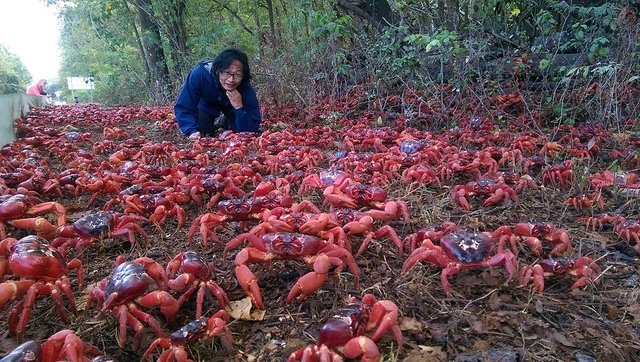
Source
The most noteworthy purpose of an out of date well of magma in the Indian Ocean, this Australian district is eminent for its splendid red shellfish. Christmas Island is home to the Christmas Island red crab, a species neighborhood to the island that can't be found wherever else on the planet. Around 40– 50 million red crabs live on Christmas Island. For an extensive segment of the year, the crabs live in the rain forest, feeding on leaves and characteristic items that litter the rain timberland floor. In the midst of the dry season, they tunnel burrows and pull back underground to keep up their body soddenness.
Wet season regularly begins in the midst of October or November, which empowers the crabs to leave their passages and make their yearly trek to the shores to breed. Connecting with the Moon stages, grown-up crabs go to the shoreline first and tunnel "mating burrows." Females trail. In this time, Christmas Island is swarmed with seas of red crabs as they move to the shore. Along vivaciously trafficked courses, lanes are closed and tunnels are attempted to outfit the crabs with safe section. Male red crabs return to the rain woodlands resulting to mating is finished. Females take after approximately two weeks sometime later after they release their eggs into the ocean. In addition, a month starting there forward, youngster crabs ascend out of the water and take after their folks stride as they progress inland.
_____________________________________________________________________________________________________
#4. Kauai, Hawaiian Islands- Chickens
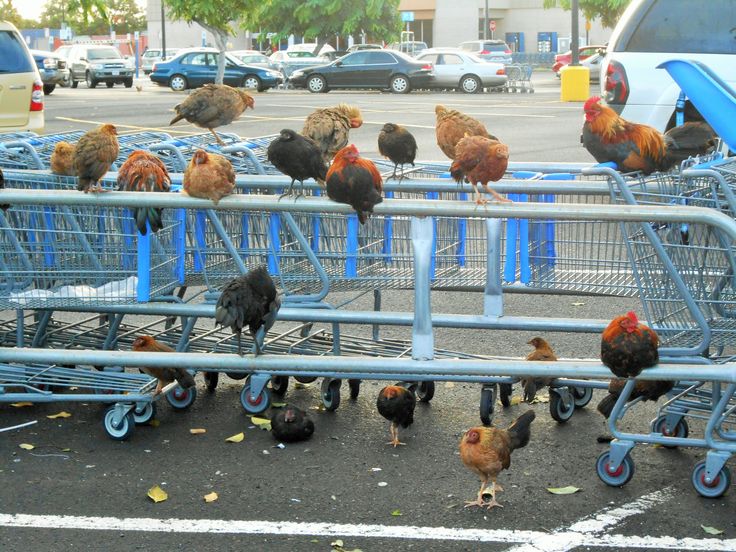
Source
The Hawaiian islands are brimming with odd contextual investigations of presented species gone wild, however none as adorable as the a huge number of chickens on Kauai. The non domesticated chickens, hens, and chicks have no common predators on Kauai, so the population has spun wild. (The mongooses that keep chickens on alternate islands in line aren't found on Kauai.) These chickens have adjusted to feast upon feline sustenance, rubbish, scraps from travelers, and local bugs.
Biologist have appreciated them, as they aren't your standard chickens. A current hereditary investigation demonstrates that they may really be half and halves of chicken predecessors brought from Polynesia several years prior, and plain old local chickens that circumvented amid later tropical storms.
______________________________________________________________________________________________________
#5. Seal Island-seal

Source
Seal Island is a save situated in False Bay off the shoreline of Cape Town, South Africa. There are no sandy shorelines or vegetation on the little stone landmass, yet the island is shrouded in Cape hide seals. Their population is assessed to be around 75,000. Seal Island is uninhabited and untouchable to vacationers, however the remaining parts of cottages regularly utilized via sealers in the mid 1900s and a mutilated World War II radio pole demonstrate that people invested energy in the island in the past. Though still chased in different nations, for example, neighboring Namibia, Cape hide seals have been an ensured animal categories in South Africa since 1973.
But that does not mean they are protected from predators. During specific circumstances of the year, especially the winter months (June through August), the waters encompassing Seal Island are known as the Ring of Death. Incredible Great white sharks that feast upon the seals circle the island searching for a wonderful treat. While the island itself does not allow guests, vessel voyages through False Bay enable individuals to see the Cape hide seals sunning themselves or playing in the water. Also, those overcome enough can confine plunge during times of high shark movement for a very close experience with the seal-parched Great whites.
______________________________________________________________________________________________________
#6. Assateague Island-Wild Horses
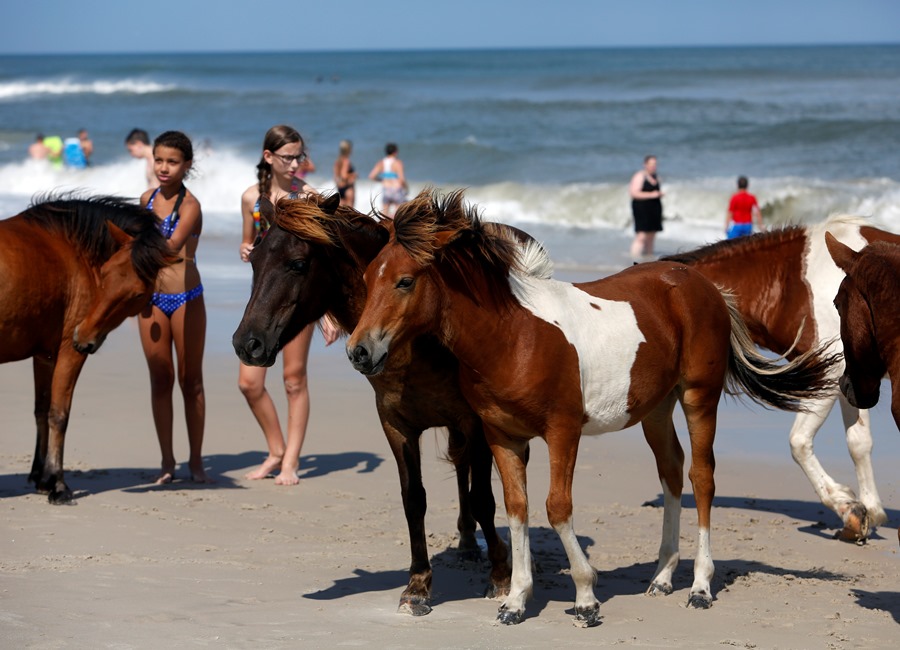
Source
Assateague Island is home to roughly 300 wild Horses. The island lies off the shores of both Maryland and Virginia and has a place with the two states. The northern 66% of the island is a piece of Maryland, and a fence isolates the southern Virginia bit of the island. The stallions are part into two groups, one in each state. The Virginia crowd is known as the "Chincoteague horses," while Maryland calls their group "Assateague's wild steeds." The Assateague "wild" stallions are actually non domesticated steeds. They slipped from tamed stallions that returned to a wild state. Some say that the Chincoteague horses ought to be called steeds, not horses, but rather they did in truth turn into an enlisted breed ("Chincoteague Pony") in 1994.
The normal tallness of a stallion on Assateague Island falls inside the parameters of a horse as opposed to a steed. Their littler form is believed to be a consequence of their eating routine, which comprises basically of damp grasses that contain few nutrients.Exactly how the steeds came to live on Assateague Island isn't known. Neighborhood legend asserts that they were survivors of a long-back wreck.
Aficionados of this hypothesis call attention to the high number of wrecks in the territory and additionally the normal routine with regards to transporting stallions by watercraft. Others trust that the steeds were conveyed to Assateague Island in the late 1600s from the territory by proprietors hoping to abstain from fencing laws and domesticated animals taxation. The stallions on the island are a mainstream fascination, however recollect that they are not local pets. Consistently, guests who get excessively near the steeds wind up getting kicked or nibbled
______________________________________________________________________________________________________
#7. Tonawanda Island-Cats
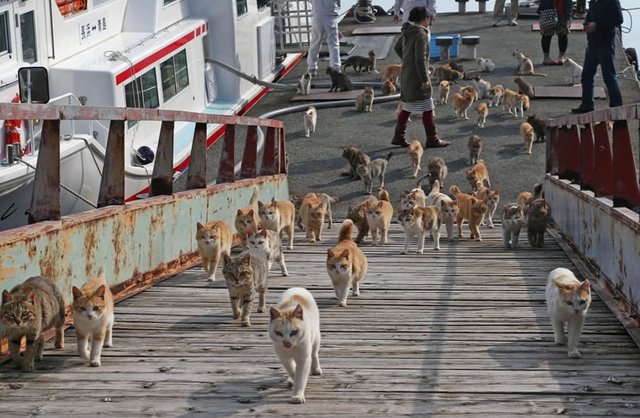
Source
A little New York island on the Niagara River is populated by not a lot of people however is home to a huge horde of stray felines. Two or three years back, Tonawanda Island was overpowered with a few wiped out, uncared-for Cats. While a segment of the felines may have found their own specific way onto the island, people had been spotted basically dropping off bothersome Cats. The Cats left compost everywhere and proceeded onward board boats that were docked in the marina.
They were an unsettling influence that gave the island a horrendous scent. Danielle Coogan, who lives on the domain in North Tonawanda, went to the island's pervasive restaurant in 2014. Coogan was shocked by the Cats situation and made a move. She started a fundraiser called "Activity Island Cats" that was to a great degree fruitful. With the money raised, Coogan and a social event of volunteers could trap, settle, and inoculate the cats that lived on the island. Young little felines were set up for determination, however more settled felines were returned to their island home. The felines that live on Tonawanda Island now are secured against rabies and ordinary feline afflictions and are unequipped for making litters of more strays. The Tonawanda Island Cats were doing extraordinary, notwithstanding they experienced a trouble a year prior.
The money raised had moreover been used to put asylums and supporting stations on the island. In spring 2016, the island's diner had a group endeavoring to clean up the outcome of a fire in the marina. Somehow, the group ended up bulldozing all the feline safe houses and feeders. The proprietors of the diner request that the damage was a mishap. None of the Tonawanda Island felines were harmed, and Coogan was endeavoring to raise blessings to supplant what was pummeled.
______________________________________________________________________________________________________
#8.Lambay Island-Wallabies
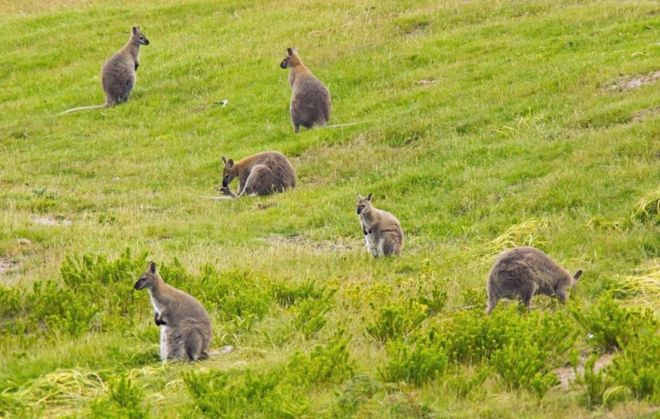
Source
Wallabies, a marsupial local to Australia, are additionally flourishing with an island off the shoreline of Ireland. Lambay is a private island that falsehoods 14,500 kilometers (9,000 mi) far from where wallabies are normally found. In Australia, wallabies appreciate hotter climate, while Lambay Island infrequently observes temperatures transcend the 15-degree-Celsius (60 °F) range. But the island has soak bluffs and shakes that wallabies like, and the Lambay wallabies have adjusted to the cooler atmosphere by developing thicker layers of hide.
Wallabies are likewise bashful creatures, and they appear to value the peace and security of this secluded island. Wallabies were presented by the island's proprietors in the 1950s. Of different species including tortoises and reptiles, wallabies were the main non-locals to get by on Lambay Island. In the mid-1980s, the island got seven extra wallabies from a Dublin zoo that could never again house them.
It was not known what number of wallabies were on the island before that, and the present correct numbers are inaccessible in light of the fact that the creatures are not labeled. Checking them is troublesome because of their inclination to cover up, however the Lambay Island wallaby population is assessed to be in the around of 30 and 50.
______________________________________________________________________________________________________
#9. Año Nuevo Island- Elephant seal.
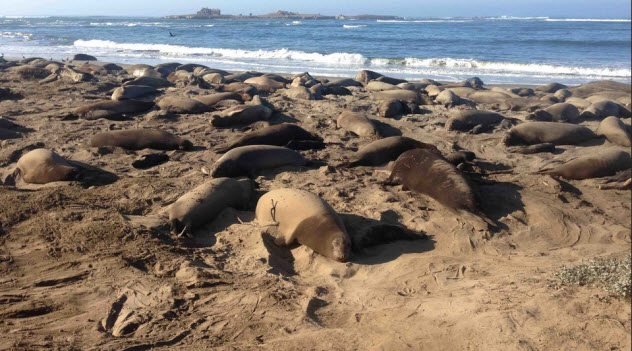
Source
The nine-section of land island that falsehoods 0.8 kilometers (0.5 mi) off the bank of northern California is a standout amongst the most thickly populated creature shelters on Earth. Two hundred years back, Año Nuevo Island was associated with California's territory by a low promontory.
The animal groups that has profited most from Año Nuevo Island is the northern Elephant seal. At one time, the Pacific Ocean overflowed with a huge number of Elephant seals. They were chased for their fat so forcefully in the 1800s that their numbers had dropped to somewhere close to 50 and 100 by 1892.
But Año Nuevo Island turned into the affection shack that brought the northern elephant seals again from the verge of annihilation. The principal elephant seal was spotted on the island in 1955, and the main pup was conceived there six years later.Since at that point, the territory has been utilized as a prevalent rearing and birthing site by northern elephant seals, with upwards of 2,000 pups conceived on the island in one year. Today, their developing populace is almost 160,000
______________________________________________________________________________________________________
#10. Cayo Santiago, Puerto Rico -Monkeys
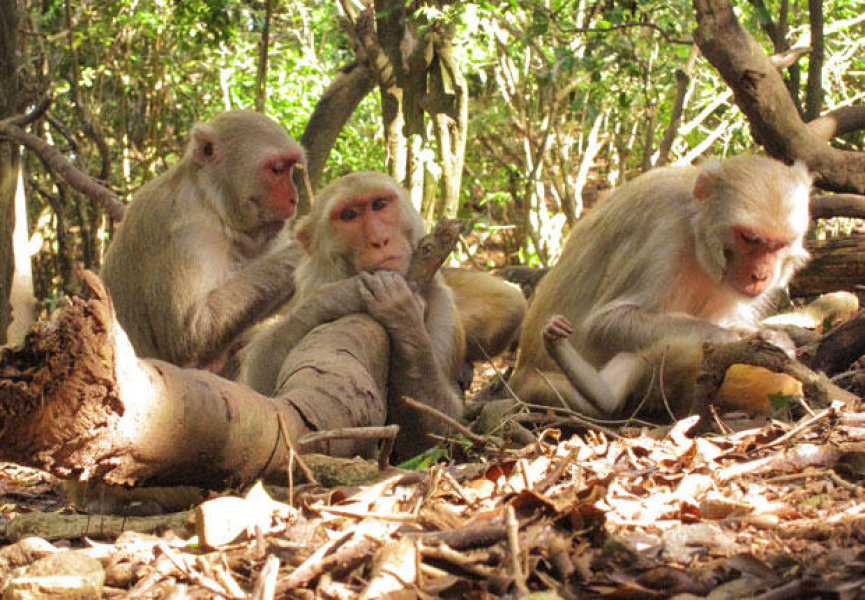
Source
Around 400 Rhesus monkeys were imported from India to this little research island in 1938, and the population has dramatically increased to around 1000 since. No people possess the island, in spite of the fact that it remains an exploration place for numerous colleges. You can just observe Monkey Island (yes, a few people call it Monkey Island) from a kayak off the shore, in any case, as Rhesus monkeys are bearers of Herpes B. Not all that charming.
______________________________________________________________________________________________________
#11. Zao Fox Village, Japan -Foxes
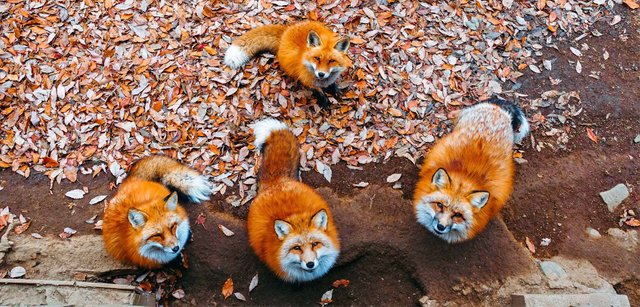
Source
While not precisely an overwhelm island, this place is excessively capricious not, making it difficult to say. In the mountains of the Miyagi Prefecture on the primary Japanese island of Honshu, an asylum holds more than 100 wandering foxes of six distinct writes. Despite the fact that they are wild, guests can stroll among them, and they don't appear to be especially bashful.
______________________________________________________________________________________________________
#12. Runde Island, Norway- Puffins

Source
The rough cliffs neglecting the Norwegian Sea are home to around 700,000 seabirds, the most celebrated of which are the puffins. Puffins are cute and—an irregularity on this rundown—a non-intrusive species. The island just has around 100 tenants, yet is very prevalent, as you may envision, among birdwatchers. On the off chance that you visit, remain the night in the beacon manager's home, which has been transformed into a self-benefit lodge.
______________________________________________________________________________________________________
#13. Gough Island-House Mice
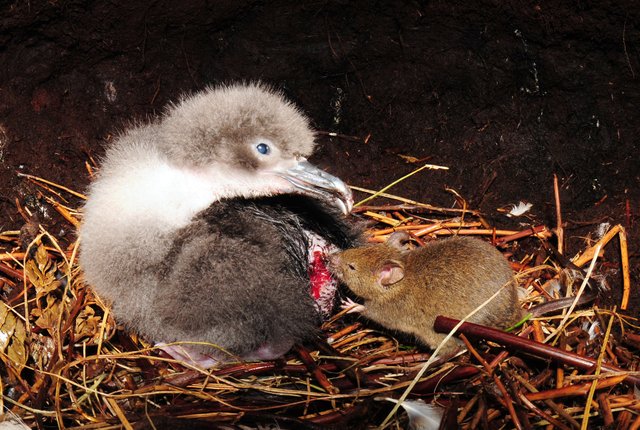
Source
Mice can be charming, however this specific story takes a monstrous turn. At some point in the 1800s, a couple of small house mice strayed from a whaling ship onto a disengaged island in the South Atlantic. Mice, which generally rummage for creepy crawlies and seeds, are apparently not the most exceedingly awful obtrusive species you could envision. Be that as it may, at that point, the mice … changed. They've adjusted to wind up top predators on account of a shocking trap they got—decimating seabird alive.
While the chicks are considerably bigger than the mice, they are fundamentally unprotected, and their folks aren't accustomed to warding off predators. As the mice ended up flesh eating, they've likewise become substantially bigger than an average mouse. These goliath executioner mice have assumed control over the little island, jeopardizing its uncommon seabirds, and driving scientists to design a destruction program.
______________________________________________________________________________________________________
#14. Miyajima Island, Japan-Deer

Source
This little island in Hiroshima Bay has turned into a safe house for deer, as has the city of Nara on the primary island of Honshu. Deer population are viewed as a pest in a few districts of Japan, yet they've turned into a draw at these spots. Many sika deer meander and parlor calmly in the roads, where vacationers sustain them liberally. The Nara deer have even grabbed a trap bow to one, and it will bow back in return for sustenance.
______________________________________________________________________________________________________
#15.Big Major Cay, The Bahamas- Pigs
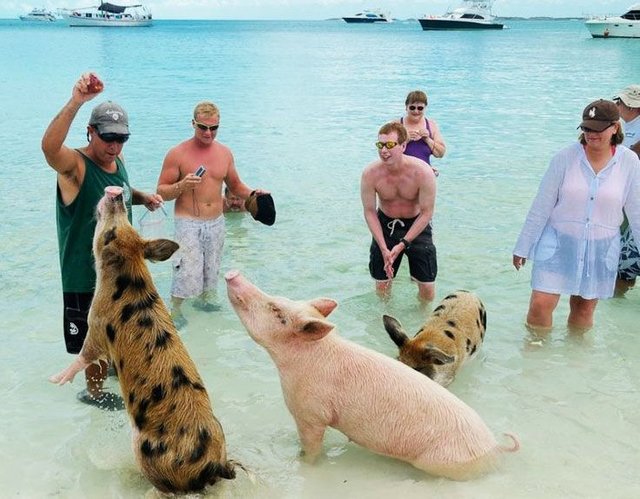
Source
Pigs of all shapes and sizes spend their days sleeping on the shoreline and sprinkling around in the blue waters of this little island in the Caribbean. Around 20 pigs and piglets now live on the shoreline, and inhabit slightest to a limited extent on nourishment from voyagers, who visit the island to swim with them. At the point when a vessel approaches the pigs' shoreline (Pig Beach), the creatures routinely paddle out for food.
There are numerous root stories about how their progenitors arrived surviving a disaster area, dumped by previous owner from a close by island, planted as a traveler draw. In any case, they've been surviving and rearing throughout recent years.
______________________________________________________________________________________________________
I hope you enjoyed reading this article. I would love to travel to this place someday. Do you? :)
